Ning Gui
Non-stationary Diffusion For Probabilistic Time Series Forecasting
May 07, 2025Abstract:Due to the dynamics of underlying physics and external influences, the uncertainty of time series often varies over time. However, existing Denoising Diffusion Probabilistic Models (DDPMs) often fail to capture this non-stationary nature, constrained by their constant variance assumption from the additive noise model (ANM). In this paper, we innovatively utilize the Location-Scale Noise Model (LSNM) to relax the fixed uncertainty assumption of ANM. A diffusion-based probabilistic forecasting framework, termed Non-stationary Diffusion (NsDiff), is designed based on LSNM that is capable of modeling the changing pattern of uncertainty. Specifically, NsDiff combines a denoising diffusion-based conditional generative model with a pre-trained conditional mean and variance estimator, enabling adaptive endpoint distribution modeling. Furthermore, we propose an uncertainty-aware noise schedule, which dynamically adjusts the noise levels to accurately reflect the data uncertainty at each step and integrates the time-varying variances into the diffusion process. Extensive experiments conducted on nine real-world and synthetic datasets demonstrate the superior performance of NsDiff compared to existing approaches. Code is available at https://github.com/wwy155/NsDiff.
Ordering-Based Causal Discovery for Linear and Nonlinear Relations
Oct 08, 2024



Abstract:Identifying causal relations from purely observational data typically requires additional assumptions on relations and/or noise. Most current methods restrict their analysis to datasets that are assumed to have pure linear or nonlinear relations, which is often not reflective of real-world datasets that contain a combination of both. This paper presents CaPS, an ordering-based causal discovery algorithm that effectively handles linear and nonlinear relations. CaPS introduces a novel identification criterion for topological ordering and incorporates the concept of "parent score" during the post-processing optimization stage. These scores quantify the strength of the average causal effect, helping to accelerate the pruning process and correct inaccurate predictions in the pruning step. Experimental results demonstrate that our proposed solutions outperform state-of-the-art baselines on synthetic data with varying ratios of linear and nonlinear relations. The results obtained from real-world data also support the competitiveness of CaPS. Code and datasets are available at https://github.com/E2real/CaPS.
Frequency Adaptive Normalization For Non-stationary Time Series Forecasting
Sep 30, 2024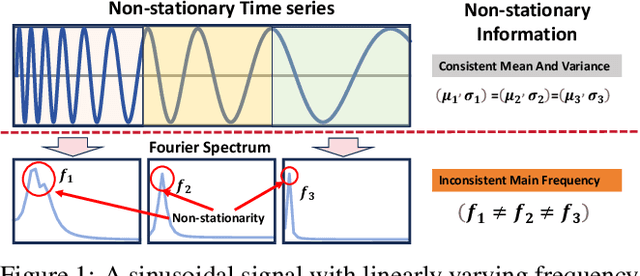

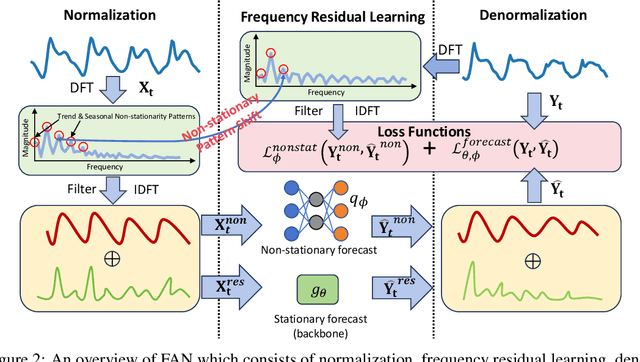
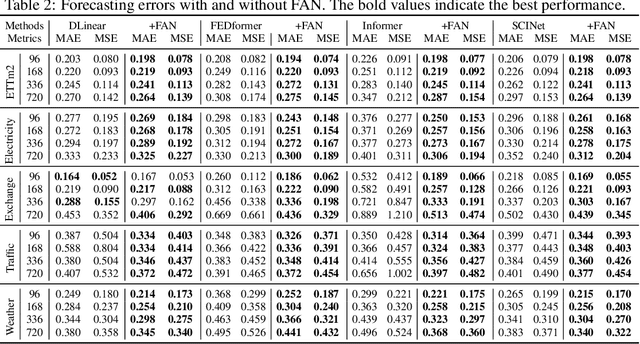
Abstract:Time series forecasting typically needs to address non-stationary data with evolving trend and seasonal patterns. To address the non-stationarity, reversible instance normalization has been recently proposed to alleviate impacts from the trend with certain statistical measures, e.g., mean and variance. Although they demonstrate improved predictive accuracy, they are limited to expressing basic trends and are incapable of handling seasonal patterns. To address this limitation, this paper proposes a new instance normalization solution, called frequency adaptive normalization (FAN), which extends instance normalization in handling both dynamic trend and seasonal patterns. Specifically, we employ the Fourier transform to identify instance-wise predominant frequent components that cover most non-stationary factors. Furthermore, the discrepancy of those frequency components between inputs and outputs is explicitly modeled as a prediction task with a simple MLP model. FAN is a model-agnostic method that can be applied to arbitrary predictive backbones. We instantiate FAN on four widely used forecasting models as the backbone and evaluate their prediction performance improvements on eight benchmark datasets. FAN demonstrates significant performance advancement, achieving 7.76% ~ 37.90% average improvements in MSE.
Are Large Language Models Really Robust to Word-Level Perturbations?
Sep 27, 2023Abstract:The swift advancement in the scales and capabilities of Large Language Models (LLMs) positions them as promising tools for a variety of downstream tasks. In addition to the pursuit of better performance and the avoidance of violent feedback on a certain prompt, to ensure the responsibility of the LLM, much attention is drawn to the robustness of LLMs. However, existing evaluation methods mostly rely on traditional question answering datasets with predefined supervised labels, which do not align with the superior generation capabilities of contemporary LLMs. To address this issue, we propose a novel rational evaluation approach that leverages pre-trained reward models as diagnostic tools to evaluate the longer conversation generated from more challenging open questions by LLMs, which we refer to as the Reward Model for Reasonable Robustness Evaluation (TREvaL). Longer conversations manifest the comprehensive grasp of language models in terms of their proficiency in understanding questions, a capability not entirely encompassed by individual words or letters, which may exhibit oversimplification and inherent biases. Our extensive empirical experiments demonstrate that TREvaL provides an innovative method for evaluating the robustness of an LLM. Furthermore, our results demonstrate that LLMs frequently exhibit vulnerability to word-level perturbations that are commonplace in daily language usage. Notably, we are surprised to discover that robustness tends to decrease as fine-tuning (SFT and RLHF) is conducted. The code of TREval is available in https://github.com/Harry-mic/TREvaL.
Multi-View Graph Representation Learning Beyond Homophily
Apr 15, 2023Abstract:Unsupervised graph representation learning(GRL) aims to distill diverse graph information into task-agnostic embeddings without label supervision. Due to a lack of support from labels, recent representation learning methods usually adopt self-supervised learning, and embeddings are learned by solving a handcrafted auxiliary task(so-called pretext task). However, partially due to the irregular non-Euclidean data in graphs, the pretext tasks are generally designed under homophily assumptions and cornered in the low-frequency signals, which results in significant loss of other signals, especially high-frequency signals widespread in graphs with heterophily. Motivated by this limitation, we propose a multi-view perspective and the usage of diverse pretext tasks to capture different signals in graphs into embeddings. A novel framework, denoted as Multi-view Graph Encoder(MVGE), is proposed, and a set of key designs are identified. More specifically, a set of new pretext tasks are designed to encode different types of signals, and a straightforward operation is propxwosed to maintain both the commodity and personalization in both the attribute and the structural levels. Extensive experiments on synthetic and real-world network datasets show that the node representations learned with MVGE achieve significant performance improvements in three different downstream tasks, especially on graphs with heterophily. Source code is available at \url{https://github.com/G-AILab/MVGE}.
Data Imputation with Iterative Graph Reconstruction
Dec 06, 2022Abstract:Effective data imputation demands rich latent ``structure" discovery capabilities from ``plain" tabular data. Recent advances in graph neural networks-based data imputation solutions show their strong structure learning potential by directly translating tabular data as bipartite graphs. However, due to a lack of relations between samples, those solutions treat all samples equally which is against one important observation: ``similar sample should give more information about missing values." This paper presents a novel Iterative graph Generation and Reconstruction framework for Missing data imputation(IGRM). Instead of treating all samples equally, we introduce the concept: ``friend networks" to represent different relations among samples. To generate an accurate friend network with missing data, an end-to-end friend network reconstruction solution is designed to allow for continuous friend network optimization during imputation learning. The representation of the optimized friend network, in turn, is used to further optimize the data imputation process with differentiated message passing. Experiment results on eight benchmark datasets show that IGRM yields 39.13% lower mean absolute error compared with nine baselines and 9.04% lower than the second-best.
A-SFS: Semi-supervised Feature Selection based on Multi-task Self-supervision
Jul 19, 2022

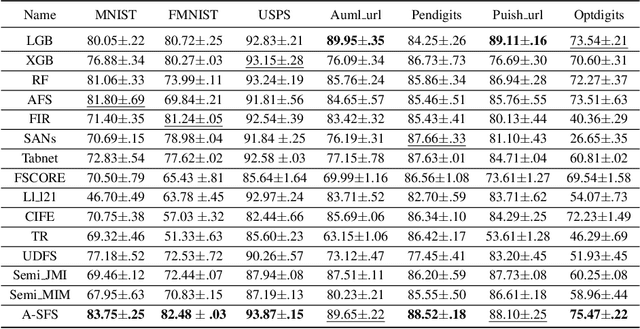

Abstract:Feature selection is an important process in machine learning. It builds an interpretable and robust model by selecting the features that contribute the most to the prediction target. However, most mature feature selection algorithms, including supervised and semi-supervised, fail to fully exploit the complex potential structure between features. We believe that these structures are very important for the feature selection process, especially when labels are lacking and data is noisy. To this end, we innovatively introduce a deep learning-based self-supervised mechanism into feature selection problems, namely batch-Attention-based Self-supervision Feature Selection(A-SFS). Firstly, a multi-task self-supervised autoencoder is designed to uncover the hidden structure among features with the support of two pretext tasks. Guided by the integrated information from the multi-self-supervised learning model, a batch-attention mechanism is designed to generate feature weights according to batch-based feature selection patterns to alleviate the impacts introduced by a handful of noisy data. This method is compared to 14 major strong benchmarks, including LightGBM and XGBoost. Experimental results show that A-SFS achieves the highest accuracy in most datasets. Furthermore, this design significantly reduces the reliance on labels, with only 1/10 labeled data needed to achieve the same performance as those state of art baselines. Results show that A-SFS is also most robust to the noisy and missing data.
An Embedded Feature Selection Framework for Control
Jun 19, 2022

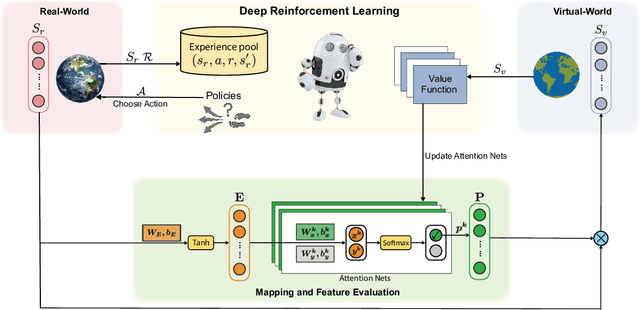
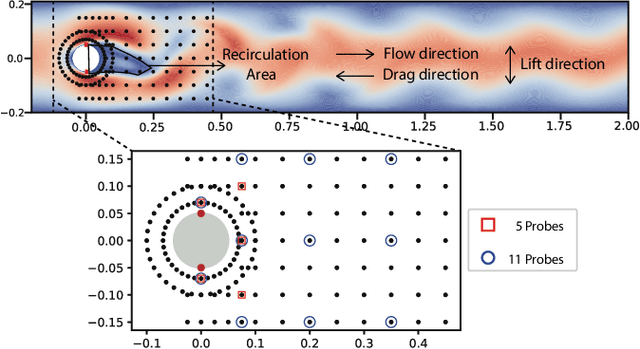
Abstract:Reducing sensor requirements while keeping optimal control performance is crucial to many industrial control applications to achieve robust, low-cost, and computation-efficient controllers. However, existing feature selection solutions for the typical machine learning domain can hardly be applied in the domain of control with changing dynamics. In this paper, a novel framework, namely the Dual-world embedded Attentive Feature Selection (D-AFS), can efficiently select the most relevant sensors for the system under dynamic control. Rather than the one world used in most Deep Reinforcement Learning (DRL) algorithms, D-AFS has both the real world and its virtual peer with twisted features. By analyzing the DRL's response in two worlds, D-AFS can quantitatively identify respective features' importance towards control. A well-known active flow control problem, cylinder drag reduction, is used for evaluation. Results show that D-AFS successfully finds an optimized five-probes layout with 18.7\% drag reduction than the state-of-the-art solution with 151 probes and 49.2\% reduction than five-probes layout by human experts. We also apply this solution to four OpenAI classical control cases. In all cases, D-AFS achieves the same or better sensor configurations than originally provided solutions. Results highlight, we argued, a new way to achieve efficient and optimal sensor designs for experimental or industrial systems. Our source codes are made publicly available at https://github.com/G-AILab/DAFSFluid.
Graph Representation Learning Beyond Node and Homophily
Mar 03, 2022



Abstract:Unsupervised graph representation learning aims to distill various graph information into a downstream task-agnostic dense vector embedding. However, existing graph representation learning approaches are designed mainly under the node homophily assumption: connected nodes tend to have similar labels and optimize performance on node-centric downstream tasks. Their design is apparently against the task-agnostic principle and generally suffers poor performance in tasks, e.g., edge classification, that demands feature signals beyond the node-view and homophily assumption. To condense different feature signals into the embeddings, this paper proposes PairE, a novel unsupervised graph embedding method using two paired nodes as the basic unit of embedding to retain the high-frequency signals between nodes to support node-related and edge-related tasks. Accordingly, a multi-self-supervised autoencoder is designed to fulfill two pretext tasks: one retains the high-frequency signal better, and another enhances the representation of commonality. Our extensive experiments on a diversity of benchmark datasets clearly show that PairE outperforms the unsupervised state-of-the-art baselines, with up to 101.1\% relative improvement on the edge classification tasks that rely on both the high and low-frequency signals in the pair and up to 82.5\% relative performance gain on the node classification tasks.
Pair-view Unsupervised Graph Representation Learning
Dec 11, 2020



Abstract:Low-dimension graph embeddings have proved extremely useful in various downstream tasks in large graphs, e.g., link-related content recommendation and node classification tasks, etc. Most existing embedding approaches take nodes as the basic unit for information aggregation, e.g., node perception fields in GNN or con-textual nodes in random walks. The main drawback raised by such node-view is its lack of support for expressing the compound relationships between nodes, which results in the loss of a certain degree of graph information during embedding. To this end, this paper pro-poses PairE(Pair Embedding), a solution to use "pair", a higher level unit than a "node" as the core for graph embeddings. Accordingly, a multi-self-supervised auto-encoder is designed to fulfill two pretext tasks, to reconstruct the feature distribution for respective pairs and their surrounding context. PairE has three major advantages: 1) Informative, embedding beyond node-view are capable to preserve richer information of the graph; 2) Simple, the solutions provided by PairE are time-saving, storage-efficient, and require the fewer hyper-parameters; 3) High adaptability, with the introduced translator operator to map pair embeddings to the node embeddings, PairE can be effectively used in both the link-based and the node-based graph analysis. Experiment results show that PairE consistently outperforms the state of baselines in all four downstream tasks, especially with significant edges in the link-prediction and multi-label node classification tasks.
 Add to Chrome
Add to Chrome Add to Firefox
Add to Firefox Add to Edge
Add to Edge